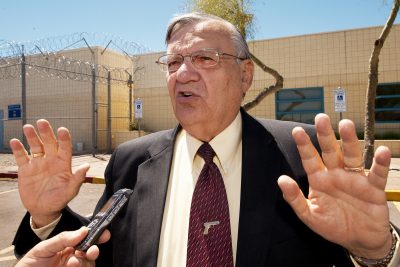Trump hailed Joe Arpaio’s “admirable service” in Arizona. There’s more to his career than that
by Ryan Gabrielson
President Donald Trump issued his first pardon to Joe Arpaio, the former Maricopa County sheriff famous for using his local police force to aggressively pursue undocumented immigrants. In its official statement, the White House credited Arpaio with “more than fifty years of admirable service to our nation,” which made him “a worthy candidate” for a pardon.
Below is a list of essential reading on one of the most reviled and beloved lawmen in the U.S.
In November 2004, Arpaio won re-election to his fourth term as sheriff and quickly set about reorganizing the police force by transferring some 140 deputies to different positions. Mark Flatten, then a reporter at the East Valley Tribune, found evidence the moves were tied to the deputies’ political loyalty, or lack thereof, to Arpaio. “Those who worked to re-elect the sheriff moved into more prized positions,” Flatten wrote. “An analysis of the transfers of sworn officers by the Tribune shows deputies who backed Saban, Arpaio’s rival in the Republican primary last September, were moved to such jobs as transporting prisoners or standing watch in courtrooms.”
The sheriff’s office had long feuded with the Phoenix New Times, an alternative weekly newspaper that broke major stories about misconduct by Arpaio’s force. In August 2007, the agency’s top commanders teamed with local prosecutors to subpoena seemingly every document inside the newsroom, ostensibly as part of a criminal probe. The order warned the New Times that it was a crime to disclose anything about the subpoena. Michael Lacey and Jim Larkin, then New Times’ publishers, did not remain silent.
That October, the newspaper plastered across its front page the headline: Breathtaking Abuse of The Constitution,” and provided the public with every detail. The subpoena demanded “every note, tape, and record from every story written about Sheriff Arpaio by every reporter over a period of years,” the publishers wrote. Worse yet, the sheriff’s office wanted information on the newspaper’s readers, including “every individual who looked at any story, review, listing, classified, or retail ad over a period of years.” Sheriff’s deputies arrested Lacey and Larkin at their homes the evening they published, and held them for several hours.
Arpaio allowed William Finnegan, staff writer at The New Yorker, to attend his meetings, ride along in his car, and interview his top commanders at great length in early 2009. The result of that access is a revealing, unsparing profile of Arpaio and the police force he ran at the peak of its illegal immigration enforcement.
In July 2008, the East Valley Tribune published a multipart investigation of the sheriff’s office’s immigration enforcement and overall police work. The agency’s arrest rate had plummeted, emergency response times soared, deputies were shelving sex crime cases without investigation, and the immigration arrests often involved unconstitutional practices. Arpaio was also using the immigration operations as a form of patronage. The sheriff’s office argued it pursued undocumented immigrants because they were a public safety threat. But agency records showed Arpaio often directed deputies to target day laborers along specific locations at the request of his supporters in the state Legislature and local businesses in his hometown of Fountain Hills. “I have a strange old philosophy that if someone does something for you, gives you resources, gives you money, I think if they want something back, we ought to do it,” Arpaio said in an interview.
Jacques Billeaud, a reporter for The Associated Press, revisited the office’s uninvestigated sex crime cases in 2011, and detailed multiple cases in which children were reportedly assaulted. The story prompted Arpaio to apologize for these failures for the first time.
Maricopa County taxpayers spent roughly $92 million on court settlements, awards, and legal bills during Arpaio’s 24 years as sheriff, The Arizona Republic calculated. Of that, $28 million was paid for “legal matters listed as civil-rights violations, false arrest, conspiracy and malicious prosecution.” And $30 million was spent on lawsuits stemming from the county’s jails.
New Times has reported scores of stories about egregious abuse and misconduct by sheriff’s employees inside the jails. Among them is a 1997 story about Richard Post, a wheelchair-bound paraplegic, who suffered a broken neck when corrections officers strapped him in a restraint chair for six hours. A decade later, Ambrett Spencer was pregnant with a baby girl while an inmate in Maricopa County jail. Suffering severe pain, Spencer waited four hours for the jail to transfer her to a hospital. Her daughter, Ambria, died of internal bleeding before she was delivered. Pregnant women were in significant peril in Arpaio’s jails. From the New Times: “The water well in the facility where pregnant women are jailed has been infested with mice and mice feces since 2005, Maricopa County Environmental Health Services Records show.”
Joe Dana, a reporter at Phoenix’s NBC affiliate, revealed that the sheriff’s office spent nearly $300,000 in 2007 and 2008 to build a criminal intelligence data system and provide training for the Honduran national police. It remains unclear why this occurred.
The sheriff’s office effectively entrapped an inmate in a fake plot to assassinate Arpaio, for which the agency purchased bomb parts, as told in an exhaustive Phoenix Magazine narrative. The inmate was acquitted at trial and later won a million-dollar legal settlement.
The sheriff’s office also helped gain clearance for a Chinese software engineer to work inside an intelligence center in Phoenix that houses federal and local law enforcement, including FBI counter-intelligence agents, for several months in 2007, reporting by ProPublica and the Center for Investigative Reporting found. The engineer worked on a facial recognition system using Arizona’s driver’s license database. He abruptly returned to China, taking time to aggressively erase the computers he’d worked on, while packing other hardware, before boarding his flight home.



